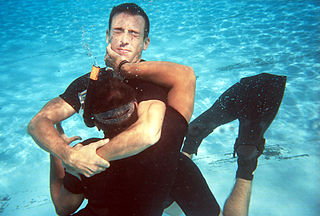Gallery
- A field player cap
- A goalkeeper cap
- Underwater hockey players wearing water polo caps
- Underwater rugby players wearing water polo caps
A water polo cap is a piece of headgear used in water polo and a number of underwater sports. The caps are used to identify both the player and their team, and to protect their ears from injury possibly caused by a water polo ball hitting the head.
Caps are differentiated by the number printed on them as well as the color. Players from the visiting team will wear dark caps, whereas the home team players will wear white caps. The goalkeepers wear quartered red caps, numbered "1", while substitute goalies have caps which are either numbered "1-A" in NCAA games, or "13" in FINA international games. [1] Thus, each team will have two sets of caps: one white and the other dark colored. According to the NFHS water polo uniform rules, the numbers on the cap contrast the color of the cap, and both the color of the cap and the color of the number contrast the color of the ball. [2]
In underwater football, underwater hockey and underwater rugby, water polo caps are worn by competitors to identify which teams they are playing for, and to offer some protection to individuals against the possibility of a burst eardrum caused by the blade of a fin making direct contact across the ear. [3] [4] [5] [6] Opponents in underwater hockey and underwater rugby wear either one of two colours - white or dark (i.e. blue or black) caps while the water referees wear red caps. [7] [8] Underwater football appears to follow this precedent. [9] Caps are also used in Aquathlon (underwater wrestling) for identification purposes; one competitor wears either a red or blue coloured cap while the other competitor wears a white or yellow coloured cap. [10]

Freediving, free-diving, free diving, breath-hold diving, or skin diving, is a mode of underwater diving that relies on breath-holding until resurfacing rather than the use of breathing apparatus such as scuba gear.

Underwater hockey (UWH), also known as Octopush in the United Kingdom, is a globally played limited-contact sport in which two teams compete to manoeuvre a puck across the bottom of a swimming pool into the opposing team's goal by propelling it with a hockey stick.

Finswimming is an underwater sport consisting of four techniques involving swimming with the use of fins either on the water's surface using a snorkel with either monofins or bifins or underwater with monofin either by holding one's breath or using open circuit scuba diving equipment. Events exist over distances similar to swimming competitions for both swimming pool and open water venues. Competition at world and continental level is organised by the Confédération Mondiale des Activités Subaquatiques. The sport's first world championship was held in 1976. It also has been featured at the World Games as a trend sport since 1981 and was demonstrated at the 2015 European Games in June 2015.

Underwater rugby (UWR) is an underwater team sport in which two teams compete to score a negatively buoyant ball into the opponents’ goal at the bottom of a swimming pool. It originated from the physical fitness training programs in German diving clubs during the early 1960s. Recognized by the Confédération Mondiale des Activités Subaquatiques (CMAS) in 1978, it was first played in a world championship in 1980.
CMAS one-star scuba diver is the entry-level diving certification for recreational scuba diving issued by the Confédération Mondiale des Activités Subaquatiques (CMAS).
Underwater sports is a group of competitive sports using one or a combination of the following underwater diving techniques - breath-hold, snorkelling or scuba, usually including the use of equipment such as diving masks and fins. These sports are conducted in the natural environment at sites such as open water and sheltered or confined water such as lakes and in artificial aquatic environments such as swimming pools. Underwater sports include the following - aquathlon, finswimming, freediving, spearfishing, sport diving, underwater football, underwater hockey, underwater ice hockey, underwater orienteering, underwater photography, underwater rugby, underwater target shooting and underwater video.

The World Underwater Federation orCMAS is an international federation that represents underwater activities in underwater sport and underwater sciences, and oversees an international system of recreational snorkel and scuba diver training and recognition. It is also known by its Spanish name, Confederación Mundial De Actividades Subacuáticas. Its foundation in Monaco during January 1959 makes it one of the world's oldest underwater diving organisations.
The Finswimming World Championships is the peak international event for the underwater sport of finswimming. These are conducted on behalf of the sport's governing body, Confédération Mondiale des Activités Subaquatiques (CMAS) by an affiliated national federation.

Aquathlon is an underwater sport, where two competitors wearing masks and fins wrestle underwater in an attempt to remove a ribbon from each other's ankle band in order to win the bout. The "combat" takes place in a 5-metre (16 ft) square ring within a swimming pool, and is made up of three 30-second rounds, with a fourth round played in the event of a tie. The sport originated during the 1980s in the former USSR and was first played at international level in 1993. It was recognised by the Confédération Mondiale des Activités Subaquatiques (CMAS) in 2008. Combat aquathlon practice training engagements not only under water, but also afloat, above the water surface, both with or without diving gear, utilizing dummy weapons or barehanded, combined with grappling and choking techniques in order to neutralize or submit the opponent.
The Australian Underwater Federation (AUF) is the governing body for underwater sports in Australia.
Sport diving is an underwater sport that uses recreational open circuit scuba diving equipment and consists of a set of individual and team events conducted in a swimming pool that test the competitors' competency in recreational scuba diving techniques. The sport was developed in Spain during the late 1990s and is currently played mainly in Europe. It is known as Plongée Sportive en Piscine in French and as Buceo De Competición in Spanish.
Underwater Target Shooting is an underwater sport/shooting sport that tests a competitors’ ability to accurately use a speargun via a set of individual and team events conducted in a swimming pool using freediving or Apnoea technique. The sport was developed in France during the early 1980s and is currently practiced mainly in Europe. It is known as Tir sur cible subaquatique in French and as Tiro al Blanco Subacuático in Spanish.

The South African Underwater Sports Federation (SAUSF) is the official CMAS (World Underwater Federation) representative in the Republic of South Africa, and is affiliated to the South African Sports Confederation and Olympic Committee (SASCOC).
Underwater orienteering, also known as scuba orienteering is an underwater sport that uses recreational open circuit scuba diving equipment and consists of a set of individual and team events conducted in both sheltered and open water testing the competitors' competency in underwater navigation. The competition is principally concerned with the effectiveness of navigation technique used by competitors to swim an underwater course following a route marked on a map prepared by the competition organisers, a compass and a counter meter to measure the distance covered. The sport was developed in the Soviet Union during the late 1950s and is played mainly in Europe. It is known as Orientation Sub in French and as La Orientación Subacuática in Spanish. Historically, the sport has also been known as Technical Disciplines.
The Underwater Orienteering World Championships is the peak international event for the underwater sport of underwater orienteering. The event is conducted on behalf of the Confédération Mondiale des Activités Subaquatiques (CMAS) by an affiliated national federation. The championships was first held in 1973. Currently, it is held every 2 years on years ending with an odd number.
Underwater photography is a scuba-based underwater sport governed by Confédération Mondiale des Activités Subaquatiques (CMAS) where teams of competitors using digital underwater camera systems all dive at the same saltwater ocean sites at the same time over a two-day period. The submitted digital images are then assessed and ranked by a jury using a maximum of five photographic categories as well as an overall score. The sport was developed prior to 1985 as a photographic film-based event and is currently mainly practised in non-English speaking countries.
The Underwater Photography World Championships is the peak international event for the underwater sport of underwater photography. The event is conducted on behalf of the Confédération Mondiale des Activités Subaquatiques (CMAS) by an affiliated national federation. The championships was first held in 1985. Two variants of the championship are offered. The first is held at an open water site and has been conducted on 16 occasions as of November 2017. Its official title often includes the world ‘sea’ in order to distinguish it from the second which is held in a swimming pool. The swimming pool variant which is concerned with a number of creative categories has held twice with a third championship scheduled for Bari, Italy during 2004 being cancelled due to low competitor registration.
The 14th CMAS Underwater Photography World Championship was held from April 9 – 14, 2013 in Cuba at Cayo Largo. David Barrio of Spain was announced as the CMAS World Champion in underwater photography for 2013 and received the gold medal while runners-up Stefano Proakis and Michele Davino both representing Italy respectively received the silver and bronze medals.
The Underwater Society of America (USOA) is the peak body for underwater sport and recreational diving in the United States.
The Underwater Hockey European Championships is a biennial tournament in underwater hockey organised by the sports global governing body Confédération Mondiale des Activités Subaquatiques (CMAS). The first event was held in the United Kingdom in 1985.
{{cite web}}: CS1 maint: archived copy as title (link)